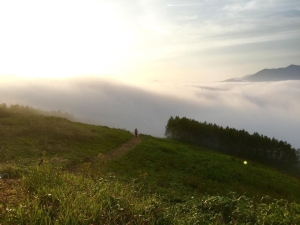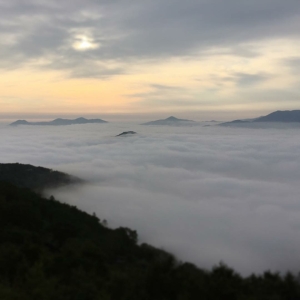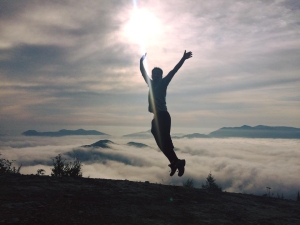The idea of a 30K ‘trail run’ the day after Xterra Japan didn’t seem too crazy initially (after all, running the marathon at ironman Sweden 2 weeks prior never felt that painful, and the recovery even less so), and despite a 5am start (why??), once I finished the xterra in one piece, I didn’t think twice before entering the race. I was eager to get a last run in before a 2 week hiatus in terms of training, and also to have a last good taste of nature before heading to the metropolis.
I went there with my Saucony Virrata, a light road racer that is, not in any way designed for any kind off road action…but I thought I’d be fine since the terrain was mostly dry…Also on the start line I found myself rather out of place, not only for being the only non Asian, but also for being by far the most evidently unprepared – no camel back, no sticks, no long sleeves, etc. All I had to save me was compression calf guards and a couple of salt tablets and Powerbar shots in my pocket.
Off we went and straight up the steepest slope that was (we’re in a ski resort here, why make things complicated?); we ran about 3 minutes tops and then we were all walking (well, scrambling) until a (majestic!) dear came out of the fog to tell us we’d reached the first summit. I took the lead as I assumed (go figure!) I’d be faster than anyone downhill, but by the time we’d reached the bottom again I was in 5th and not comfortable. We stayed in a group of 6 for about an hour and a half until we hit another vertical ascent and I decided to ‘attack’. As we were all walking up a 30% slope this was easily the slowest surge I have ever done (!), but still I got to the top in first and enjoyed all the cheers from the (many) tourists who’d risen almost as early as us (but instead of putting on the running shoes had opted for the gondola to take them to the summit – and enjoy the unkai (sea of clouds) that forms every morning in the valley before disappearing).
At this point I was in pretty high spirits, leading the race and surrounded with magical views, and almost subconsciously I ‘did’ the next descent without the brakes on. Sure enough I had opened a decent gap by the time I was at the bottom again. I reached the start/finish line and thought I was done…until I was told to do another loop…without any GPS device I’d thought 2 hours of running must have been close to 30k, but clearly it wasn’t. By then I was tired, dehydrated and slightly dizzy, and running (walking) up that slope again was a real nightmare.
At the top the unkai below me didn’t interest me the slightest, and I stopped briefly to drink a red bull (I would never otherwise, but that was the only choice and in my sorry state it tasted like heaven) before making my way down…but I quickly realised that as hard as going up had been, going down was gonna be much worse. Like torture actually…You’re going downhill and you’re feeling a little relief despite the fatigue because it’s the last hill of the course…then the pain in your legs suddenly shoots up and the next thing you know you’re practically hobbling across the last few miles. My quads had blown and there was nothing I could do. I watched one guy flying by like he was just starting the race, and hobbled to the finish line in 2nd, after almost 2 hours and 50 minutes of racing.
4 days later as I’m writing this post I am still unable to walk down the stairs without help. The symptoms are rather simple:
– the quads are very ‘tender, warm and swollen’ and if someone squeezes your leg you’ll instinctively want to punch them (NB: they never see the funny side of your response)
– when you stretch, it makes no difference to the tenderness, the pain still exists (it’s not tight, its damaged) and its probably better if you actually don’t stretch!
So what happened?
Well ultra runners call this ‘dead quads’ or ‘blown quads’. You know you’re in trouble when there’s a tear or strain on what are considered to be your strongest and leanest muscles. The acute pain and tightness on the front side of the thighs is an injury to the quadriceps muscles. Sometimes this kind of injury is manageable enough to let you plow on through to the end, sometimes you just can’t go on (for sure I couldn’t have done another descent!).
What specifically triggers muscle soreness are the high force eccentric contractions we experience when we take up unaccustomed exercise, run harder than usual, or downhill. Running downhill is an eccentric movement, one which runners are not often used to. Our leg muscles lengthen under high load or impact, while trying to contract or shorten – a lethal combination! In other words the quadriceps have to work eccentrically with every landing. This means the muscle is working whilst it is lengthening as opposed to a concentric contraction which is when the muscle works as it shortens. Eccentric contractions do far more damage to muscles than concentric contractions. Eccentric movements focus on slowing down the elongation of the muscle process, challenging the muscles. This type of movement provides a braking mechanism for the muscles. For example, as you run downhill, you must brake with your legs to keep your body in control of your movements. Holding your body in a more controlled fashion and slowing down your stride can cause more soreness to develop in the legs (that was me in that last descent!).
Eccentric contractions are also the explanation for DOMS; or Delayed Onset Muscle Soreness, which manifests hours, or even days after a run. Recent research shows that some people are high responders to eccentric exercise, meaning that their muscle damage and inflammatory markers remain excessively high for several days after running (that’s me right there).
So before I attempt such a run again (granted I didn’t expect the race to be that hard, but really being in mountain territory I should have known better), I’ll make sure I’ll do some regular squats in the gym as well as incorporate some hills in most of my runs. And I’ll bring some trail shoes. And a pair of sticks…




Pingback: Cedric Lassonde Woo Blog | Cedric Lassonde
Pingback: Cedric Lassonde Woo Blog | Cedric Lassonde